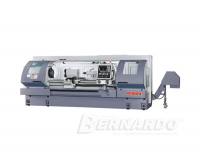A lathe processed workpieces:
are usually metallic and symmetrical in its simplest. However, other forms can be developed with the help of additional components and developments. The peculiarity of the lathe is that the cutting action is performed by the workpiece itself while the cutters or but another tool for processing is securely clamped. Up to the present modern lathes and in particular of the CNC lathe was however a long way.
The history of the lathe.
The exact birth of the lathe is today no longer accurately to write down, but already from the second century before Christ, finds that suggest first workpieces with a lathe processed during this period exist. With these machines, even today wood work piece be edited using a technique that is very similar to that of metal using a lathe. The principle of lathe then the first time was in writing deposited in the year 300 before Christ. De construction was still very simple: someone had to keep the workpiece moving with a cord while someone else held the chisel or other tool to the tool. This technique was further developed in the following centuries: in the eighth century, the workpiece using a fiddle bow drive in motion was brought and held. In the thirteenth century, there was the first rocker lathes, which are also called rocker
lathe.
The further development of the lathe
The manual was used in the fifteenth century. A by Leonarda da Vinci could not prevail but developed concept: in this development the workpiece has been linked to a flywheel via running Board in rotation. He took advantage of his lathe but techniques that have been shown already 1480: A lathe with a runner, which to the cutters as well as the possibility to move the workpiece in the longitudinal direction. This lathe has been improved in 1571, Jaques Bessson developed a lathe with automatic feed. Since that time, the lathe developed rapidly. Lathes were used already in the middle of the 17th century in the precision engineering, whose Teile consisted of metal to a large extent. Already from the middle of the 18th century there were lathes, all elements of modern lathes. The first lathe, which was suitable for the mechanical engineering industry, is attributed to the American Sylvanin Brown, it was designed in 1791. in 1798, this development was patented by the American David Wilkinson. The British Henry Maudslay was able to develop it, which is completely made of metal for the first time a lathe. A further step on the way to an automatic lathe was inventing the Scotsman James Nasmyth possible: He developed the first steam-powered
lathe.
Of the lathe for the CNC lathe
The next big step took place in the fifties of the twentieth century in the United States: the first numerically controlled lathes were developed at this time, which received orders to the workpiece on paper tape. Through the development of the CNC technology and thus the CNC lathe were completely different ways of workpiece machining possible. These Lathes are used mainly in the industry, because they only require and can be programmed these machines via computer. Since the fifties of the twentieth century the term lathe has prevailed, even if by operators is still often spoken by a
lathe.
Including the CNC lathe used
The first lathes were used mainly for making screws. Even in times of the CNC lathe, you can produce these same pieces and edit. Because anyone can edit even today small workpieces using a lathe, which have to be produced in large quantities. The possibilities of processing go from forming over the drilling up to the loop and other forms of processing. So precision parts can now manufactures the, edit materials that are extremely wear resistant and heat resistant. For example, ceramic is editable very precisely. In addition, the CNC offers lathe but the advantage of that so very complicated work pieces can be produced, which differ from standard shapes. To the lathe is extended due to additional technical or electronic components, which very often include automation facilities. Furthermore, a CNC lathe always also offers the multi machine be serving ability. Also, including CAD drawings can be read and programmed directly through a special
interface.
Advantages and disadvantages of the CNC lathe
Even if the CNC lathe work much better and thanks to a possible full automation work more productively as a conventional lathe, lathe not only benefits a CNC has. Thus, a machine controlled by a computer is much more expensive than a conventional machine. Here, one must consider the potential cost savings through more efficient production. But not only the cost of the lathe should be considered. The operation of a CNC lathe also means that the operator must have the appropriate qualifications, because the establishment and upgrading of CNC lathe is very high and the operator your mind must go through and complete the process.
A compromise between the high cost of a new CNC lathe and its benefits offers a used CNC lathe.
|








